.

Due
to a lack of ambulances, cars are used to rush wounded to Shifa Hospital in Gaza
City after an explosion July 30 in the market in Shujayea: photo by Carolyn Cole / Los Angeles Times, 30 July 2014
Israel wants to hide this, to
keep us isolated from the world: Dr. Mona El-Farra in Gaza, 30 July 2014
Nora Barrows-Friedman: Dr. Mona, can you tell us
about the situation in Gaza right now, especially after the latest
Israeli missile strikes overnight and the massacre at the Shujaiya open
market earlier today?
Dr. Mona El-Farra: Yes, actually, this day in the
morning, the first massacre happened when the Israelis attacked one of
the schools in the Jabaliya refugee camp, where twenty at least were
killed and tens were injured. I lost track of numbers, but for sure the
killed were twenty.
And before that, there was heavy, heavy shelling for two or three
hours, then this massacre happened. Then, in the middle of the day, at
the Shujaiya market, when people felt safe that there was a humanitarian
ceasefire, people went to shop for a few things.
And then they were
attacked again by missiles, by the Israeli army, and seventeen at least
were killed, maybe 200 were injured, and a big, big fire stayed for
maybe one hour, you could see the smoke from the other end of town. Two
of the health workers, emergency health workers, died in that attack
too, as well as one journalist.
The situation is really very, very bad. And we have a big problem at
the moment at the hospitals and medical facilities, which are in
shortage of medications because the burden is high. The main hospital in
Gaza, al-Shifa hospital, is receiving immediately 200 cases, the
injured with different sorts of injuries. It is a big burden, it was
mass casualties with a lack of essential medication and supplies,
that’s why there was an appeal on the radio when this happened asking
people to go to the hospital to donate blood.
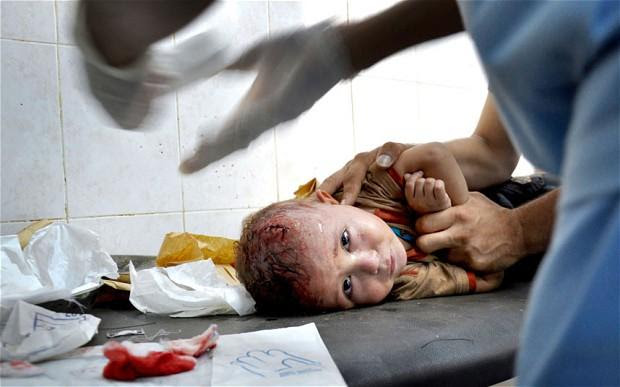
Medics treat a Palestinian child wounded in Israeli shelling of UNRWA school in Jabaliya refugee camp: photo via Joe Catron on twitter, 30 July 2014
And we don’t have power at the moment. We don’t have water. And when
we don’t have power, the generators at the hospitals will start to not
function well. So an imminent humanitarian health problem is coming soon
if this continues. For us, for me, working at the Red Crescent Society
in the Gaza Strip, which is partnered with the Middle East Children’s
Alliance, we receive every day an increasing number of patients coming
from the schools, people who took shelter in the schools or with their
relatives. There are very bad health conditions, and increasing numbers
of infectious diseases like gastroenteritis, upper respiratory tract
infections and skin diseases.
We are not used to this great number of patients daily, we receive
between 200-250 patients coming and asking for health consultation at
our center. Again, we have a diagnostic center, and the hospital,
al-Shifa hospital, their equipment like the CT [scanner] has stopped
working, so we receive cases at our center. Every day we receive an
increasing number of injured who are in need for diagnostic procedure
like the CT.
Today, I came across three cases coming for a CT. Three cases with
head injuries. The first one, her name is Buthaina el-Izraia, she came
to our diagnostic center with a head injury and many shrapnels all over
her body besides the head injury.
And her son was next to her, this patient. She was accompanied by her
son, who is a newly-graduated nurse. His name is Yousef el-Izraia, and
he was crying and telling me, “My mother was watering her plants when
the shrapnel hit her, and we have never ever been members of any
political party or militant [group]. We are just normal people, ordinary
civilians.”
This was the first case. The second story -- a child, three years old,
and the name of this child is “Anonymous number six.” He came with a
head injury as well. And you understand why he was “Anonymous” -- that
means the child has lost its whole family, and they couldn't determine who
the child is.
Another case, her name is Reem Ahmad, again with a head injury, from
Nuseirat refugee camp, six years old. And again, she lost all the
members of her family.
These stories are common already in Gaza, but it attracted my
attention -- a human being called “Anonymous number six.” Or a woman, a
peaceful woman trying to plant her flowers, trying to normalize an
abnormal life, and then the result is to be hit with a head injury. And I
don’t know if they will make it or not. After they come to our center,
they go back to the hospital to resume their treatment.
Another story — one of our staff, she is a nurse, her name is Afaf
Hussein, and this morning I heard that her daughter was killed with her
three grandchildren and two of her children. I tried to call her phone
several times and she couldn’t answer the phone. Her daughter was one of
our volunteers a few months ago in our center.

Paramedic going to help treat and transport those with injuries, but now he wants one to help him: photo by Dr. Saeed Kanafany, 30 July 2014
We are surrounded with death. We are surrounded with horror. We are
surrounded with a lack of facilities and we try hard to help people, we
try hard to help each other, but the burden is heavy and the attack is
very serious, and this should stop now.
NBF: What does it mean for Palestinians in Gaza to
be cut off from the outside world because of the electricity crisis, as
well as being cut off from family members and loved ones and neighbors
as the phone networks are going down?
ME: This is another disaster, because this is our
lifeline to the outside world. For me, on a personal level, by the end
of the day when I come home, I start writing. I feel that I am still
alive. I still can convey the message. And not only that, we feel that
maybe something worse is happening and Israel wants to hide this, to
keep us isolated from the world, so nobody knows what crimes are going
to happen next in Gaza.
It is frightening. It is frightening.
Interview
with Dr. Mona El-Farra of the Middle East Children's Alliance and
Palestinian Red Crescent Scociety in Gaza, 30 July 2014 (Nora
Barrows-Friedman, via The Electronic Intifada)

Palestinian men move the body
of journalist Rami Rayan, the victim of an Israeli air strike on a
marketplace, to an ambulance in the Shejaiya neighborhood near Gaza City
on July 30, 2014: photo by Mahmud Hams / AFP, 30 July 2014

Those who assassinate journalists are scared of the world finding out how truly monstrous they are: photo by Dr Bassel Abuwarda, 30 July 2014

A Palestinian man gestures near
the victim of an Israeli air strike on a market place in the Shejaiya
neighborhood near Gaza City on July 30, 2014. At least 15 people were
killed and 150 people wounded in an Israeli air strike on the market,
medics said. The strike came shortly after the Israeli army said it was
observing a humanitarian lull that would be in force for four hours from
1200 GMT: photo by. Mahmud Hams / AFP, 30 July 2014

Palestinian men carry the
victim of an Israeli air strike on a market place to a stretcher near an
ambulance in the Shejaiya neighborhood near Gaza City on July 30, 2014: photo by Mahmud Hams / AFP, 30 July 2014

A Palestinian paramedic holds
the victim of an Israeli air strike at a market place in the Shejaiya
neighborhood near Gaza City, on July 30, 2014: photo by. Marco Longari / AFP, 30 July 2014

Palestinian emergency personnel
and civilians move the victim of an Israeli air strike on a market
place to an ambulance in the Shejaiya neighborhood near Gaza City on
July 30, 2014: photo by Mahmud Hams / AFP, 30 July 2014
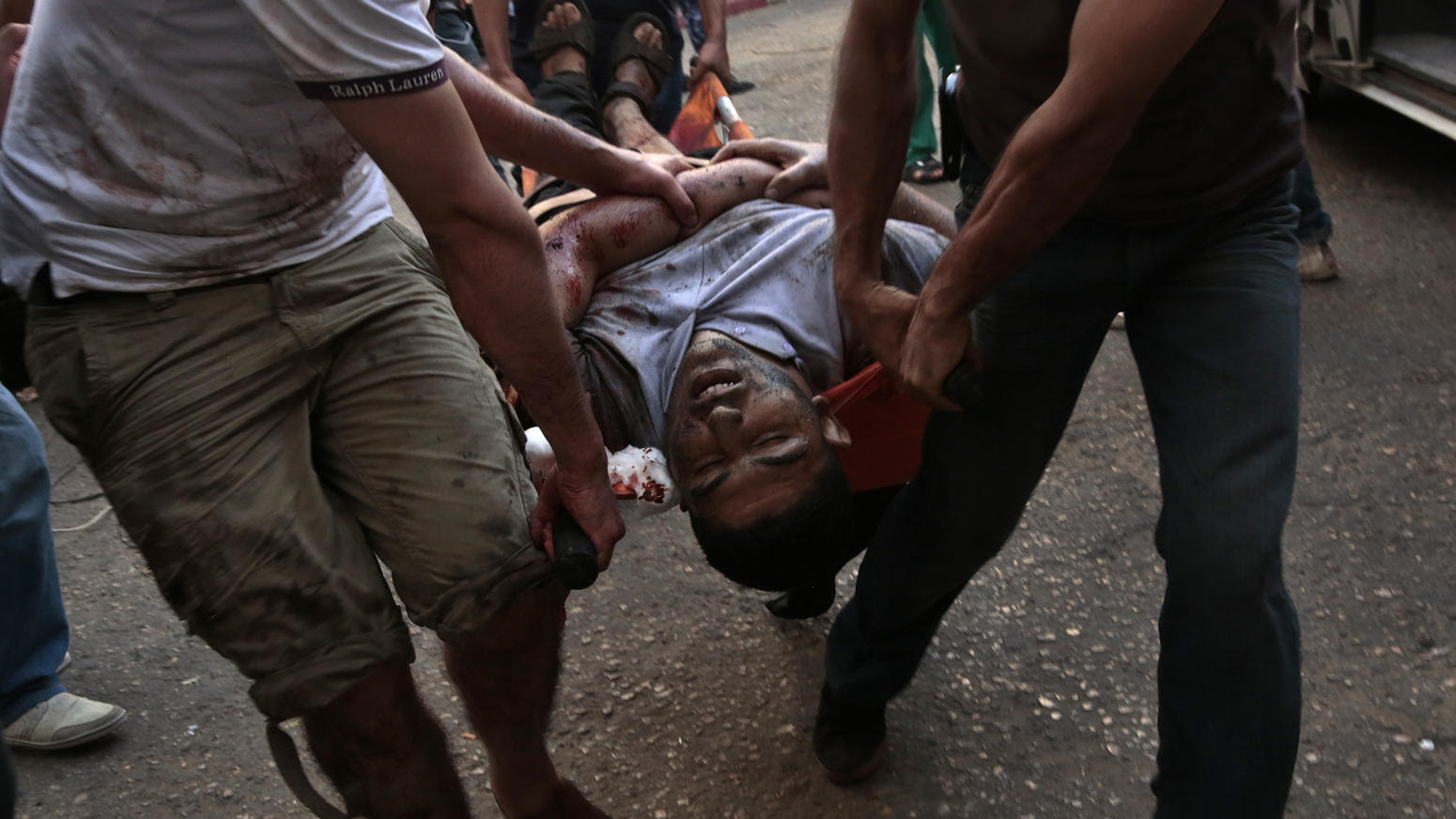
Victims are rushed to Shifa Hospital in Gaza City after an explosion July 30 in the market in Shujayea: photo by Carolyn Cole / Los Angeles Times, 30 July 2014

The
dead and wounded are rushed to Shifa Hospital in Gaza City after an
explosion July 30 in the market in Shujayea during what was supposed to
be a four-hour humanitarian cease-fire: photo by Carolyn Cole / Los Angeles Times, 30 July 2014

This was the first martyr to arrive from the Shejaiya massacre yesterday. I don't know if his sister survived: photo by Belal, 30 July 2014

Al-Shifa Hospital, today. Here, two operations in every room, and other injuries waiting on the floor: photo by Belal, 30 July 2014

Al-Shifa Hospital, today. Two operations in every room, and other injuries waiting on the floor: photo by Belal, 30 July 2014

10.40 pm, al-Shifa Hospital. Some injuries from Shejaiya massacre today are still waiting their turn for surgery. This should tell how bad the situation is!: photo by Belal, 30 July 2014

Al-Shifa, Injured receiving emergency treatment: photo by Mahmoud Abu Hamda via Dr. Saeed Kanafany, 30 July 2014
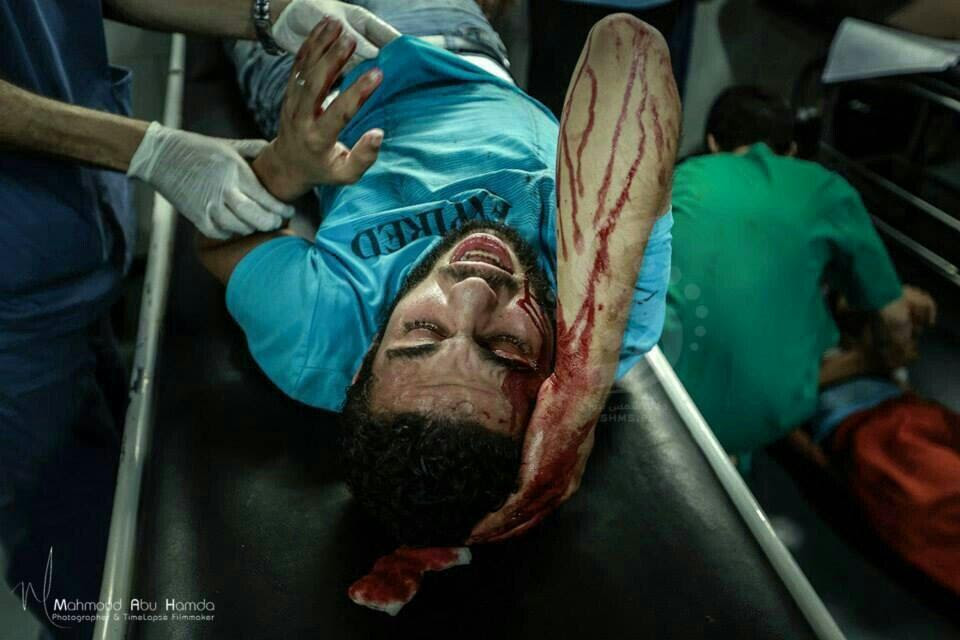
Al-Shifa, Injured receiving emergency treatment: photo by Mahmoud Abu Hamda via Dr. Saeed Kanafany, 30 July 2014

Injured were treated on the ground. It's hard to deal with more than 200 injuries that come at once: photo by Dr Bassel Abuwarda, 30 July 2014

Wounded are treated at Shifa Hospital in Gaza City on July 30 after an explosion went off in the market in Shujayea during what was supposed to be a four-hour humanitarian cease-fire: photo by Carolyn Cole / Los Angeles Times, 30 July 2014

Revised Version: doodle by Tom Raworth, 25 July 2014

UNRWA spokesperson Chris Gunness breaks down in TV interview about Israeli massacre of children in UNRWA school: screenshot via Dr Saeed Kanafany on twitter, 30 July 2014

A poster in front of a hotel in Mumbai calls for boycott of Israeli and American brands in protest against Gaza killings: photo by Vivek Bendre / The Hindu, 29 July 2014

Medical
worker, Mohammed Jameel Al Bar Bari, on July 30 finishes examining two
young children who were killed when an Israeli airstrike hit a Gaza
marketplace: photo by Carolyn Cole / Los Angeles Times, 30 July 2014
sky writing on silver-lined cloud
Here's what those hardworking tax dollars of yours were up to today while you were busy
Feel very proud

The blood-stained hand of a
Palestinian is seen as he collects human remains from a classroom inside
a UN school in the Jabalia refugee camp after the area was hit by
shelling on July 30, 2014: photo by Marco Longari, / AFP, 30 July 2014
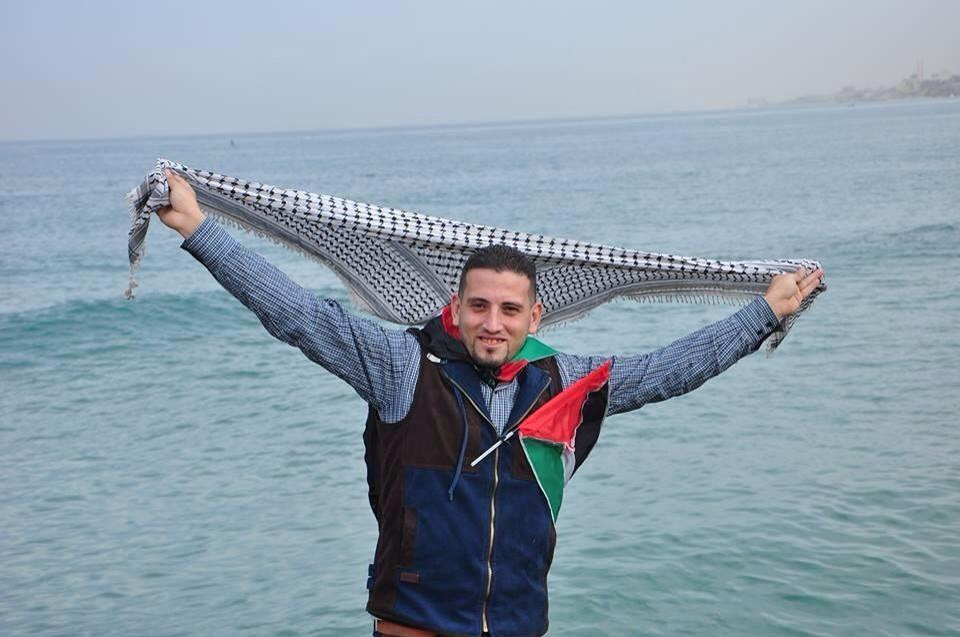
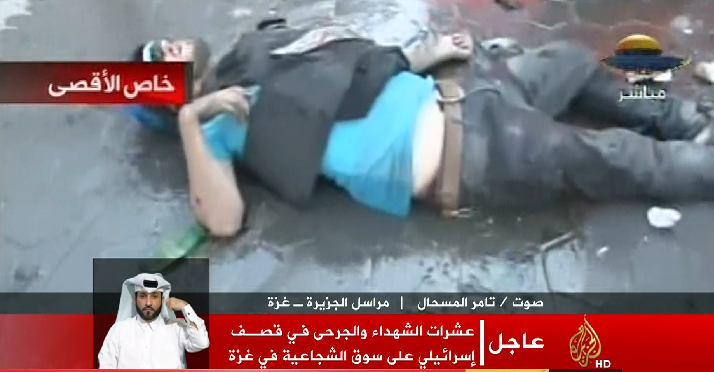




5 comments:
U.S. Gives Israel More Grenades and Mortar Rounds for Gaza Offensive
By Reuters
Filed: 7/30/14 at 5:34 PM | Updated: 7/30/14 at 7:11 PM
WASHINGTON (Reuters) - The United States has allowed Israel, waging an offensive in the Gaza Strip, to tap a local U.S. arms stockpile in the past week to resupply it with grenades and mortar rounds, a U.S. defense official said on Thursday.
The munitions were located inside Israel as part of a program managed by the U.S. military and called War Reserves Stock Allies-Israel (WRSA-I), which stores munitions locally for U.S. use that Israel can also access in emergency situations.
Israel, however, did not cite an emergency when it made its latest request about 10 days ago, the defense official said, speaking on condition of anonymity.
Newsweek Magazine is Back In Print
The United States allowed Israel to access the strategic stockpile anyway to resupply itself with 40mm grenades and 120mm mortar rounds to deplete older stocks that would eventually need to be refreshed.
"They didn't ask for it from there but we gave it to them so we could rotate our stocks," the official said.
Additional Israeli requests for U.S.-manufactured ammunition were also being processed in the United States, the official said. The official did not offer further details on quantities or costs of ammunition already supplied or requested.
Israel's embassy in Washington declined comment about the resupply request, including whether it asked for the ammunition because of its operations in Gaza.
Separately, U.S. lawmakers were working in Congress to provide millions of dollars in additional funding for Israel's "Iron Dome" missile shield.
The U.S. Senate Appropriations Committee added $225 million for Iron Dome to a spending bill intended mainly to provide money to handle an influx of thousands of Central American children across the U.S.-Mexico border.
According to the Gaza Health Ministry, 1,346 Palestinians, mostly civilians, have been killed since Israel began its offensive on July 8 with the declared aim of halting cross-border rocket fire and destroying the tunnel network of the Islamist group Hamas.
On the Israeli side, 56 soldiers and three civilians have been killed.
Thanks Tom, I'm following these terrible events through your blog every day.
Tom,
This is all shocking and sad -- haven't seen any pictures until these, these two days on your site. Thanks for keeping things (all too) real . . . .
The children's eyes; incomprehension, trauma.
Many thanks friends, always extremely consoling to hear such conscious voices. And yes -- "terrible", "shocking", "incomprehensible", "traumatic"... terms from a historical vocabulary, certainly applicable in this awful present, for all too many suffering human beings.
But one does wonder: will the horror that's happening with the world's passive permission in Gaza now ever become officially received as history, when what passes as history has become nothing more than the convenient triumphalist narrative of the power-playing of the few?
Post a Comment